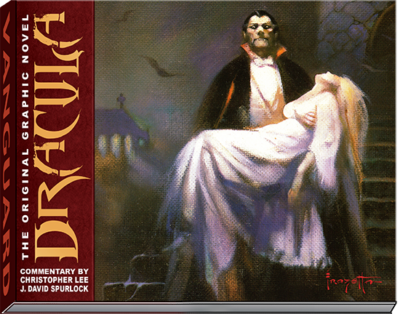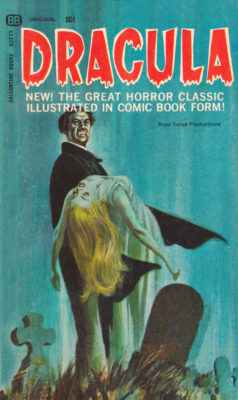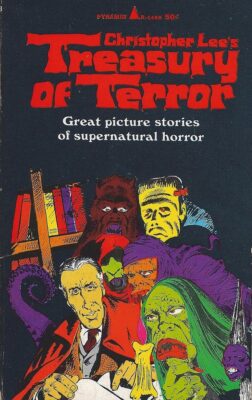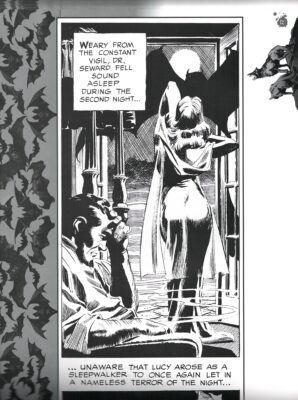1966 Dracula Graphic Novel: Spotlight by Alex Grand
Read Alex Grand’s Understanding Superhero Comic Books published by McFarland Books in 2023 with Foreword by Jim Steranko with positive reviews by comic book professionals, Jim Shooter, Tom Palmer, Tom DeFalco, Danny Fingeroth, Alex Segura, Carl Potts, Guy Dorian Sr. and more.
In the meantime enjoy the show:
In my Formative Graphic Novels of the 20th century video, there is one I can add to the list between 1956 EC Picto Fiction and 1968’s His Name Is… Savage by Gil Kane. That would be Dracula, the 1966 original graphic novel produced by Russ Jones which was recently beautifully recompiled and edited with a new foreword by Vanguard Publications and cover by Frank Frazetta available at Vanguard and Bud’s Art Books.

The illustrations are by Alden McWilliams, and script adapted by Otto Binder and Craig Tennis from Bram Stoker’s 1897 original novel with the book produced for Ballantine Books by founding Creepy editor, Russ Jones. In fact, it’s likely that Jones painted the original 1966 cover.

Alden McWilliams started work in comics in the mid 1930s and worked prolifically for multiple comic publications like Quality and Archie comics and comic strips like Dateline: Danger!, then some 1965 work with Jones on Creepy before illustrating Dracula. Otto Binder is a celebrated science fiction writer responsible for 1939 I, Robot, prolific work of the 1940s Captain Marvel, and expansion of the Superman mythos in the 1950s and 1960s. In the later 1960s Binder was still very much working in comics and books since he had lost money as editor of space world magazine. Craig Tennis is responsible for classics like Johnny Tonight and the Runners Handbook. Russ Jones originally created Creepy magazine for publisher James Warren in 1963, which was largely funded by profits from Warren’s previous publication, Famous Monsters of Filmland by Forry Ackerman. Jones is a penciler, inker, novelist and editor so he was skilled in all ways required to package a book and came up with the idea to make an EC Comics style black and white magazine that would avoid comic book censors. Jones left Creepy magazine in 1965 and started his own Russ Jones productions and assembled two books of note during this period, Dracula 1966 in which he arranged a foreword by popular Horror British actor, Christopher Lee and Christopher Lee’s Treasure of Terror in the same year for Pyramid books. I assume an arrangement was made there between the two men.

This adaptation strongly favors the appearance of Christopher Lee as Dracula, and the layouts and script are apt, to the point and clear to both understand and enjoy. The imagery matches perfectly with the tone and pacing of the script in which a reader can sense Binder’s immense experience here. Award winning Comics historian, Publisher and editor, Spurlock adds in scenes from outside material like Dracula Lives Magazine from the early 1970s sporting art by Neal Adams to further enrich the background of the graphic novel. There is also Dracula concept art by Jim Steranko for the 1992 Francis Ford Coppola film that enhances the reader experience. The isolation of Jonathan Harker in Dracula’s castle is visually and verbally told with cold absolute precision, and Dracula’s eventual travel to London well captures the desolation and despair that accompanies the titular character. As Vampire bites appear on local women’s necks, the reader is taken into an adventure of light vs darkness set in the 1800s.

It’s not easy to find an original readable 1966 copy and even though Manor Books republished The Illustrated Dracula in 1975, copies of that version are also generally in disrepair. The new Vanguard compilation of this work is the best presented publication of this material to date with superior paper quality, beautiful Frazetta cover and historical context written by historian J. David Spurlock. His overview of the history of Vlad Tepes, Bram Stoker, the Vampire myth and Dracula in film and comics makes for an informative and entertaining read. The horizontal format makes it far more readable than the vertical approach of the two former versions, making it a real pleasure to read. Do yourself a favor and get a copy to read this little known and formative graphic novel that holds a firm place in the 20th century sequential story telling experience.
Join us for more discussion at our Facebook group
check out our CBH documentary videos on our CBH Youtube Channel
get some historic comic book shirts, pillows, etc at CBH Merchandise
check out our CBH Podcast available on Apple Podcasts, Google PlayerFM and Stitcher.
Use of images are not intended to infringe on copyright, but merely used for academic purpose.
Images used ©Their Respective Copyright Holders











